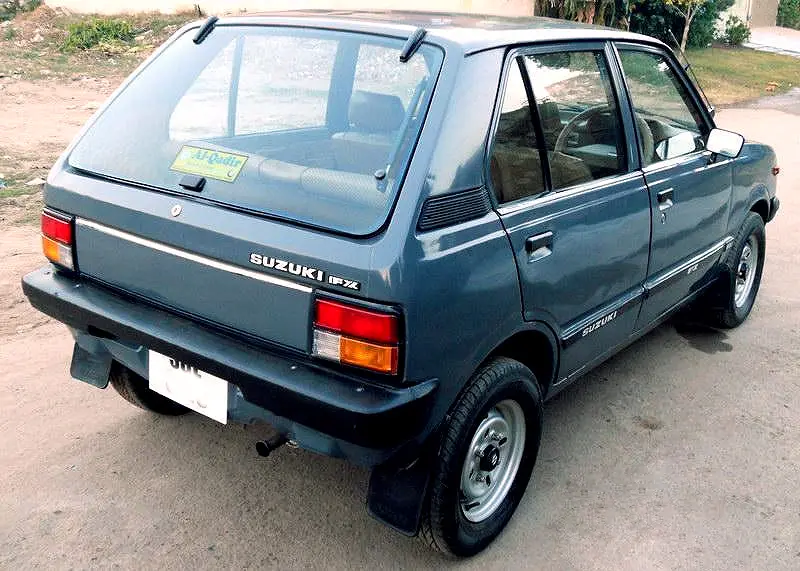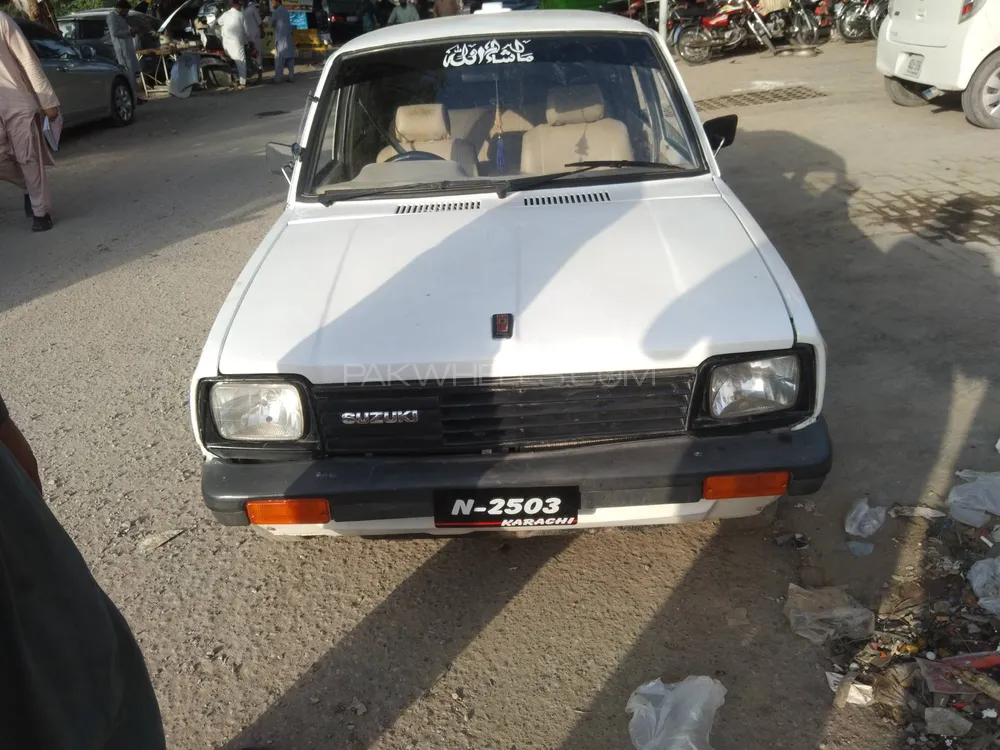Suzuki Alto FX (1984-1989): A Timeless Journey from Dreams to Driveways
Explore the legacy of Suzuki Alto FX – a classic that transformed dreams into reality. From its humble beginnings to lasting impact, dive into the vintage charm.
#SuzukiAltoFX #AutomotiveLegacy #VintageCars #ClassicJourney #CarEnthusiast
Introduction: Bridging Dreams and Driveways
Owning a car is a universal dream, and for many, it remains just that – a dream. The allure of a brand-new vehicle, while powerful, often comes with a hefty price tag. In a world where entry-level hatchbacks command a considerable sum, let's rewind to an era when the Suzuki Alto FX made car ownership a tangible reality for many. Join me as we revisit the pages of automotive history and unravel the timeless charm of the Suzuki Alto FX.
Suzuki 800: Pioneering Dreams
Back in the early 1980s, Suzuki 800, the first generation of the Alto hatchback, entered the Pakistani market, creating ripples of affordability. Priced at a modest Rs 43,000, this compact wonder shattered barriers, turning dreams of brand-new car ownership into reality. As we delve into the evolution of Suzuki 800, we'll uncover the economic and engineering brilliance that made it a household name.
Suzuki's Arrival: Setting Wheels in Motion
Suzuki's journey in Pakistan began in the mid-1970s, with pickups being assembled at Naya Daur Motors and Awami Autos Ltd. The official formation of Pak Suzuki Motor Company Limited in 1982 marked a pivotal moment, with local production commencing in 1984. This birthed the Suzuki 800 hatchback, kickstarting a revolution in affordable mobility. Join me as we trace Suzuki's footsteps, from humble beginnings to becoming a cornerstone of Pakistan's automotive landscape.
Under the Hood of Suzuki 800: Simple, Robust, Enduring
The Suzuki 800, also known as Suzuki FX in its locally assembled version, wasn't just a car; it was a testament to simplicity and resilience. Despite its fragile appearance, this workhorse endured almost 40 years and still commands a robust resale value in today's used car market. Let's dissect the engineering that made the Suzuki 800 a symbol of enduring performance.
Aesthetic Delight: Styling Through the Ages
In terms of appearance, the Suzuki 800 sported a neat and acceptable design for its time. Even today, its visual appeal stands the test of time. From circular headlamps in the initial imported batches to the transition to square headlamps during local production in 1984, the Suzuki FX evolved in style. Let's journey through the exterior hues, with an array of 12 color options, reflecting the vibrant spirit of the era.
Dimensions and Performance: Navigating the Streets of Nostalgia
Measuring 3,195mm in length, 1,395mm in width, and 1,335mm in height, the Suzuki 800 was a compact companion for city life. Its 796cc engine paired with a 4-speed manual gearbox ensured a reliable and economical ride. Join me behind the wheel as we navigate the dimensions of nostalgia, appreciating how the Suzuki 800 carved its path in a time dominated by rear-wheel-drive configurations.
Legacy in Transition: From Suzuki 800 to Mehran
While the Suzuki 800/FX marked its introduction in 1984, it had already made its debut as the Suzuki Alto in Japan in 1979. By 1988, the Suzuki FX's production concluded in Pakistan, making way for the second-generation Alto, later known as Mehran, which would go on to be in production for over three decades. Let's explore the transitional phase that paved the way for the iconic Mehran.
Global Success: Suzuki 800's Impact Beyond Borders
The first-generation Suzuki Alto (800/FX) wasn't just a success in Pakistan; it resonated globally. By the time of its discontinuation, the first-gen Alto stood as the best-selling kei car in Japan, propelling Suzuki to the seventh position in Japanese production for passenger cars. The Suzuki 800 became a symbol of affordability and efficiency, leaving an indelible mark on the global automotive stage.
Endurance Beyond Years: Suzuki 800 in Today's Roads
As we fast forward to the present, the Suzuki 800, in good condition, still commands a price tag of over Rs 1.5 lac in the used car market. Witnessing its continued presence on our roads, the Suzuki 800 stands as a testament to simple yet efficient engineering. Share your Suzuki FX experiences with us, and let's celebrate this automotive legend that turned dreams into timeless realities.
Conclusion: Celebrating Suzuki Alto FX – A Jewel in Time
In bidding farewell to the Suzuki Alto FX, we celebrate a vehicle that not only ferried generations but also etched itself into the annals of automotive history. The Suzuki 800/FX was more than a car; it was a bridge connecting dreams to driveways. As we conclude our journey, let's acknowledge the enduring charm of the Suzuki Alto FX – a timeless jewel that remains etched in the hearts of car enthusiasts across the globe.
First Generation (1979-1984): The Suzuki Alto FX Legacy
Overview
Also known as Suzuki Fronte, Suzuki FX, Suzuki Hatch, and Maruti 800, the first generation of Suzuki Alto (SS30/SS40) graced the automotive scene from 1979 to 1984. Production hubs included Japan (Kosai, Shizuoka), New Zealand (Whanganui), and Pakistan (Karachi - Pak Suzuki Motors).
Body and Chassis
The Suzuki Alto manifested as a versatile 3/5-door hatchback and a 3-door van. Its layout featured a front-engine, front-wheel-drive, or optional four-wheel-drive configuration.
Powertrain
Under the hood, this pioneer boasted various engines:
- 539 cc T5B two-stroke I3 (SS30)
- 543 cc F5A I3 (SS40)
- 796 cc F8B I3 (SS80, exclusively for export)
Transmission duties were handled by a reliable 4-speed manual gearbox.
Dimensions
The Suzuki Alto stood at a compact yet impactful stature:
- Wheelbase: 2,150 mm
- Length: 3,195 mm
- Width: 1,395 mm
- Height: 1,335 mm
- Curb Weight: 530–570 kg
Inception and Micro Sensation (1979)
Introduced in May 1979, the first generation (SS30V/40V) made waves with its three-door cargo version of the Fronte passenger car. Equipped with a folding rear seat, the Alto showcased robust engineering with front coils struts and rear leaf springs. It was powered by the T5B two-stroke 539 cc three-cylinder engine, producing 28 PS at 5500 rpm.
The Alto's affordability, priced at a groundbreaking ¥470,000 (approximately $1,900 in 1979), created a "micro sensation." This was possible due to Japanese concessions for commercial vehicles, including lenient emissions rules and exemptions from commodity tax. The success of the Alto reshaped the kei-car market, prompting competitors like Subaru to introduce cut-price "commercial" vehicles tailored for private use.
Global Impact and Evolution (1980-1981)
Suzuki grappled with overwhelming demand, propelling them to seventh place in Japanese car and truck production. In May 1980, a fully automatic two-speed option enhanced the Alto SS30. The introduction of the F5A four-stroke 543 cc in January 1981 broadened the Alto's appeal, especially in export markets like the United Kingdom.
Export Markets and Transition (1981-1984)
Export markets witnessed the Alto's versatility, marketed as both passenger cars and commercials. In Australia, the van was branded as the "Suzuki Hatch." Export versions featured twelve-inch wheels, distinct from domestic ten-inch units. The 4WD "Snow Liner" added ground clearance, and the export Altos often sported the more potent 796 cc F8B engine.
Legacy and Transition to Maruti Suzuki 800 (1984)
While the Alto continued its success, Suzuki introduced the 800 cc Alto/Fronte (FX) in Pakistan in 1984. This marked the local manufacturing era by Pak Suzuki Motors, coexisting with the 1000 cc Jimny (SJ410). The Alto's reign persisted until September 1981 when market pressures and emissions regulations led to the end of the two-stroke engine era.
Global Reach: New Zealand and India (1980-1986)
The SS80 variant of the Alto found its way to New Zealand in March 1980, assembled by South Pacific Suzuki Assemblers. Between 1983 and 1986, India witnessed the Alto's presence as the Maruti Suzuki 800, solidifying its global impact.
A Pioneer's Enduring Spirit
The first generation Suzuki Alto FX, with its economical prowess and enduring spirit, holds a cherished place in automotive history. From revolutionizing affordability to leaving an indelible mark on global markets, the Alto's legacy lives on. As we bid adieu to this pioneer, let's celebrate the Suzuki Alto FX – a trailblazer that shaped the future of compact cars.
#SuzukiAltoFX #AutomotiveLegacy #VintageCars #ClassicJourney #CarEnthusiast



.jpg/800px-1984_Suzuki_Alto_FX_(rear).jpg)














